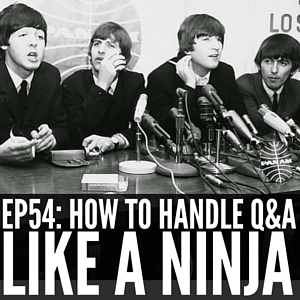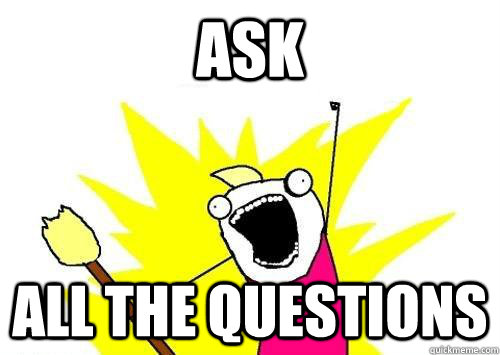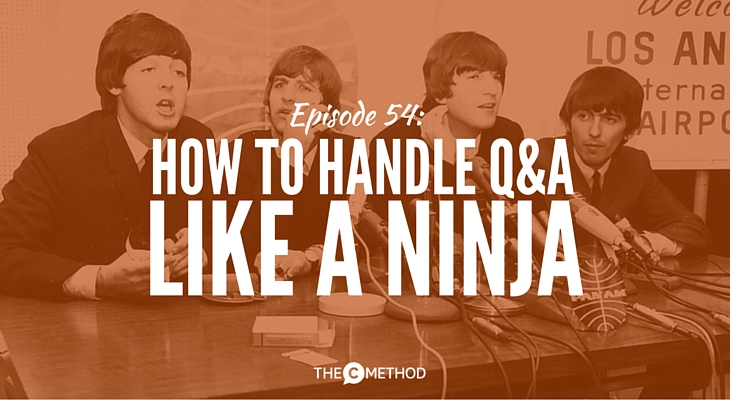 Do you freak out when taking questions from the audience?
Do you freak out when taking questions from the audience?
Maybe you feel uncomfortable being put on the spot. Maybe you’re afraid you’ll say the wrong thing, or worse – nothing at all!
It’s ok – you’re not alone.
Even practiced speakers struggle with it – at my Toastmasters meetings, the ‘table topics’ (impromptu speech) component is considered the most difficult (and the most dreaded) part of the evening. But it’s an excellent skill to have.
Here’s why:
- Being able to answer questions effectively, whether on stage or off, helps your audience to build confidence and trust in you and your ideas
- When people have trust in you, it leads to better relationships, which leads to more jobs, clients and opportunities
- This doesn’t just apply to public speaking and pitching – you can also apply these skills to job interviews, when asking for a raise, client conversations, and even difficult conversations with friends or family members
- It teaches you how to deal with the unexpected – imagine feeling confident in handling interruptions during your next presentation!
- Also, Q&A time is an opportunity to build rapport with your audience; to engage with them at a much higher level than you may during your prepared presentation.
I had my fair share of Q&A time during my month of non-stop speaking in the Philippines last month – questions ranged from “What’s the biggest regret you’ve had in your life?” to “How do I prevent mental blanks?” to “Can you sing us a song?” (yes, really), so I know how valuable it is to be able to deal with these unexpected challenges.
This question of “How do I handle Q&A?” has come up so frequently with clients in my public speaking workshops and coaching sessions, I’m sharing my tips with you in this week’s podcast episode.
Practice these tips, and you’ll soon be looking forward to question time!
9 ways to handle Q&A like a ninja
1. Change your mindset from “I hate Q&A” to “I love Q&A!”
If you truly believe that you dislike Q&A, you’ll never get better at it. View the experience as a positive instead. Think: ‘Isn’t it great I have an opportunity to share all the stuff I forgot to mention in my presentation?? Isn’t it great that people are interested in what I’m talking about! I’m so grateful that people want to ASK me questions!’

2. Remember that question time is YOUR TIME
Just because it’s question time, doesn’t mean your presentation is over. Remember, YOU’RE the one in control here. Some people in the audience will want their air time – you need to be assertive if they ask too many follow-up questions or start having arguments with other audience members.
Say “I’d love to talk more about this with you after the session – we do need to move on to another question – thank you.”
Also, remember that most people aren’t there to pick on you. Most people want you to do well, and most people genuinely want to know the answer to their question, believe it or not.
3. Buy yourself time to formulate an answer in your head
You can repeat the question, say “I love this question!”, thank them for their question, ask for clarification, etc. For example: “Where do I see myself in the next 5 years? That’s a great question, Jim, I actually love this question, thank you for asking…”
Thanking the person for asking also makes them feel special. Remember, people in the audience are often afraid they’ll ask a “stupid question”! So give them some validation – tell them they’re question’s a good one 🙂
4. Never say “I don’t know”
Instead, say: “That’s something we’re working on” or “I’ll find out for you and get back to you”. Be honest though – if you really don’t know, don’t try and bullshit your way through it. People are smart – they can sniff that out.
If it’s not your area of expertise, say something like: “I’ll find out from our tech guys – they know all the details.” As long as you show them you’ve thought about it, or you you can find out for them, you’ll be ok.

5. Don’t get defensive
Remember that everyone is entitled to their opinion, and even though you may not agree with them, show that you’re open to hearing what they have to say. Nod, smile, thank them for asking the question, say you’ve considered (or will consider) what they’ve said.
Also watch your body language. I’ve seen people cross their arms across their chest when it gets to question time – signalling defensiveness. Keep your arms unfolded, or even better, keep your palms facing the audience to show them you’re “open” to receiving feedback.

6. Deliberately leave something out
This is a nice trick I learned in Architecture school. If you tell them EVERYTHING there is to know about the project or idea, they will have nothing to nitpick on the tiny details. Leave something obvious (but not critical) out – this way, you KNOW it will come up in question time. Then when it does, you’ll be prepared with an answer. Boom!
7. When you answer, speak to the whole audience
Just because one person asked the question, doesn’t mean that no one else has the same question. When you only reply to that person, you’re excluding everyone else. Pretend that your Q&A is a series of mini speeches you’re giving to the whole audience.
8. After providing your answer, ask: “Does that answer your question?”
This is a nice way to conclude your answer, plus it demonstrates your willingness to help the person asking. Most of the time they’ll say “yes”, and then you can move on. If they want to be difficult and say “Not really”, simply say “Ok, let’s talk about it after the session, is that ok?” And then move on.
9. Finally, make note of the questions you get asked
If you’re delivering a similar presentation multiple times, take on board the questions you get asked, so you’ll be prepared for them next time. You may even want to incorporate those answers into your presentation. Again, shift your mindset – think “Q&A time is a great opportunity to learn more about my audience and what they want, which will help me be of more service to them in the future.”
I hope you enjoy this episode! Listen to the end to hear a song I prepared in anticipation of another singing request…
Do you have an upcoming Q&A session?
The tricky part about Q&A is that you can’t practice it by yourself. I mean, that’s one of the reason’s it’s so difficult, right?
That’s where you need an external person for guidance. In my personalised coaching sessions, I provide a safe environment for you to rehearse your answers to difficult questions, as well as honest, constructive feedback. The great thing about one-on-one sessions is you get 100% of my attention, meaning you will see results immediately – I’m not kidding!
So if you’d like some help for that upcoming presentation, pitch, job interview or panel session, fill out this short form to book in a free 15 minute call. We’ll establish your goals and results you want, and if working together is a good fit for both of us.
That link again: click here to fill out the coaching application form!

Leave a Reply